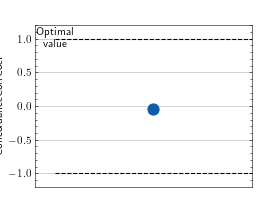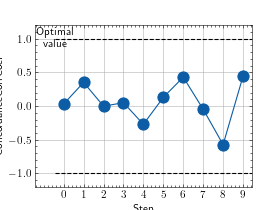Concordance Corr. Coef.¶
Module Interface¶
- class torchmetrics.ConcordanceCorrCoef(num_outputs=1, **kwargs)[source]¶
Compute concordance correlation coefficient that measures the agreement between two variables.
\[\rho_c = \frac{2 \rho \sigma_x \sigma_y}{\sigma_x^2 + \sigma_y^2 + (\mu_x - \mu_y)^2}\]where \(\mu_x, \mu_y\) is the means for the two variables, \(\sigma_x^2, \sigma_y^2\) are the corresponding variances and rho is the pearson correlation coefficient between the two variables.
As input to
forwardandupdatethe metric accepts the following input:preds(Tensor): either single output float tensor with shape(N,)or multioutput float tensor of shape(N,d)target(Tensor): either single output float tensor with shape(N,)or multioutput float tensor of shape(N,d)
As output of
forwardandcomputethe metric returns the following output:concordance(Tensor): A scalar float tensor with the concordance coefficient(s) for non-multioutput input or a float tensor with shape(d,)for multioutput input
- Parameters:
num_outputs¶ (
int) – Number of outputs in multioutput settingkwargs¶ (
Any) – Additional keyword arguments, see Advanced metric settings for more info.
- Example (single output regression):
>>> from torchmetrics.regression import ConcordanceCorrCoef >>> from torch import tensor >>> target = tensor([3, -0.5, 2, 7]) >>> preds = tensor([2.5, 0.0, 2, 8]) >>> concordance = ConcordanceCorrCoef() >>> concordance(preds, target) tensor(0.9777)
- Example (multi output regression):
>>> from torchmetrics.regression import ConcordanceCorrCoef >>> target = tensor([[3, -0.5], [2, 7]]) >>> preds = tensor([[2.5, 0.0], [2, 8]]) >>> concordance = ConcordanceCorrCoef(num_outputs=2) >>> concordance(preds, target) tensor([0.7273, 0.9887])
- plot(val=None, ax=None)[source]¶
Plot a single or multiple values from the metric.
- Parameters:
val¶ (
Union[Tensor,Sequence[Tensor],None]) – Either a single result from calling metric.forward or metric.compute or a list of these results. If no value is provided, will automatically call metric.compute and plot that result.ax¶ (
Optional[Axes]) – An matplotlib axis object. If provided will add plot to that axis
- Return type:
- Returns:
Figure and Axes object
- Raises:
ModuleNotFoundError – If matplotlib is not installed
>>> from torch import randn >>> # Example plotting a single value >>> from torchmetrics.regression import ConcordanceCorrCoef >>> metric = ConcordanceCorrCoef() >>> metric.update(randn(10,), randn(10,)) >>> fig_, ax_ = metric.plot()

>>> from torch import randn >>> # Example plotting multiple values >>> from torchmetrics.regression import ConcordanceCorrCoef >>> metric = ConcordanceCorrCoef() >>> values = [] >>> for _ in range(10): ... values.append(metric(randn(10,), randn(10,))) >>> fig, ax = metric.plot(values)

Functional Interface¶
- torchmetrics.functional.concordance_corrcoef(preds, target)[source]¶
Compute concordance correlation coefficient that measures the agreement between two variables.
\[\rho_c = \frac{2 \rho \sigma_x \sigma_y}{\sigma_x^2 + \sigma_y^2 + (\mu_x - \mu_y)^2}\]where \(\mu_x, \mu_y\) is the means for the two variables, \(\sigma_x^2, \sigma_y^2\) are the corresponding variances and rho is the pearson correlation coefficient between the two variables.
- Parameters:
- Return type:
- Example (single output regression):
>>> from torchmetrics.functional.regression import concordance_corrcoef >>> target = torch.tensor([3, -0.5, 2, 7]) >>> preds = torch.tensor([2.5, 0.0, 2, 8]) >>> concordance_corrcoef(preds, target) tensor([0.9777])
- Example (multi output regression):
>>> from torchmetrics.functional.regression import concordance_corrcoef >>> target = torch.tensor([[3, -0.5], [2, 7]]) >>> preds = torch.tensor([[2.5, 0.0], [2, 8]]) >>> concordance_corrcoef(preds, target) tensor([0.7273, 0.9887])
